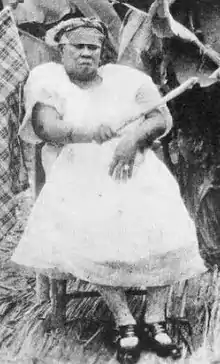Ti Memenne of La Gonâve
Queen Ti Memenne of La Gonâve (also written as Timemenne; 19th-century – fl. 1929) was the tribal ruler of La Gonâve, a Haitian island located west of Hispaniola in the Gulf of Gonâve, in the 1920s. While her reign was not officially recognized by the republican government of Haiti during American occupation, she maintained political, economic, spiritual, and social leadership of the island. Arrested by the Garde d'Haiti for being a practitioner of Vodou, she was shown compassion by Faustin E. Wirkus, an American military officer who assisted in her release. She later proclaimed Wirkus to be the reincarnation of former Haitian Emperor Faustin Soulouque and crowned him as a co-ruler over La Gonâve.
| Ti Memenne | |
|---|---|
 Queen Ti Memenne in the 1920s. | |
| Queen of La Gonâve | |
| Reign | c. 1920s |
| Co-monarch | Faustin II (1926–1929) |
| Born | La Gonâve, Haiti |
| Died | La Gonâve, Haiti |
| Religion | Haitian Vodou |
Biography
Ti Memenne was a leading figure over a group of matriarchal societies, dominating social and economic affairs on La Gonâve.[1] Her reign over La Gonâve was not officially recognized by the republican government, which had abolished the monarchy and nobility in Haiti.[1] Despite this, she was viewed by the other native people of the island as their political and spiritual leader.[1][2]
As a young woman, Ti Memenne was captured by American military officials during the United States occupation of Haiti and charged with "trivial voodoo offenses."[3][2] She received aid from Faustin E. Wirkus, an American sergeant serving in the Garde d'Haiti who had been stationed on La Gonâve.[4] Wirkus sent her to Port-au-Prince with a recommendation for lenient treatment.[3] For the next year Ti Memenne built a friendship with Wirkus, who advised her on governmental and civil matters.[1] Due to his help, and because he shared a name with the former Haitian emperor Faustin I, she and her people proclaimed Wirkus to be Faustin II in a Vodou ritual, allowing him to co-rule over La Gonâve with her for three years (1926 – 1929).[5][6][7] She reportedly believed Wirkus to be Faustin I's reincarnation.[3]
In popular culture
Ti Memenne is remembered in William Seabrook's 1929 novel The Magic Island and Wirkus' memoir The White King of La Gonave: The True Story of the Sergeant of Marines Who Was Crowned King on a Voodoo Island.[8]
References
- "Cambridge Sentinel 26 February 1944 — Cambridge Public Library's Historic Cambridge Newspaper Collection". cambridge.dlconsulting.com. Archived from the original on 5 October 2021. Retrieved 12 December 2020.
- S.A, Wirtualna Polska Media (April 23, 2014). "Sierżant Faustin Wirkus, cesarz La Gonave". opinie.wp.pl. Archived from the original on January 17, 2021. Retrieved December 12, 2020.
- "That time a Marine was crowned king of a voodoo island in Haiti". February 5, 2020. Archived from the original on November 30, 2020. Retrieved December 12, 2020.
- WILLIAMS, Arthur. "City officials face criminal charges". Prince George Citizen. Archived from the original on 2019-03-20. Retrieved 2020-12-12.
- Wirkus, Faustin E.; Dudley, Taney; Introduction by William E. Seabrook (1931). The White King of La Gonâve: The True Story of the Sergeant of Marines Who Was Crowned King on a Voodoo Island. New York: Doubleday, Doran & Company, Inc. (paperback: Ishi Press, 2015). p. 333. ISBN 978-4871872393.
- "Department of the Navy -Naval Historical Society". Archived from the original on July 8, 2010.
- "The Winnipeg Tribune from Winnipeg, Manitoba, Canada on April 25, 1931 · Page 45". Newspapers.com. Archived from the original on October 5, 2021. Retrieved December 12, 2020.
- "The White King of La Gonave". www.goodreads.com.